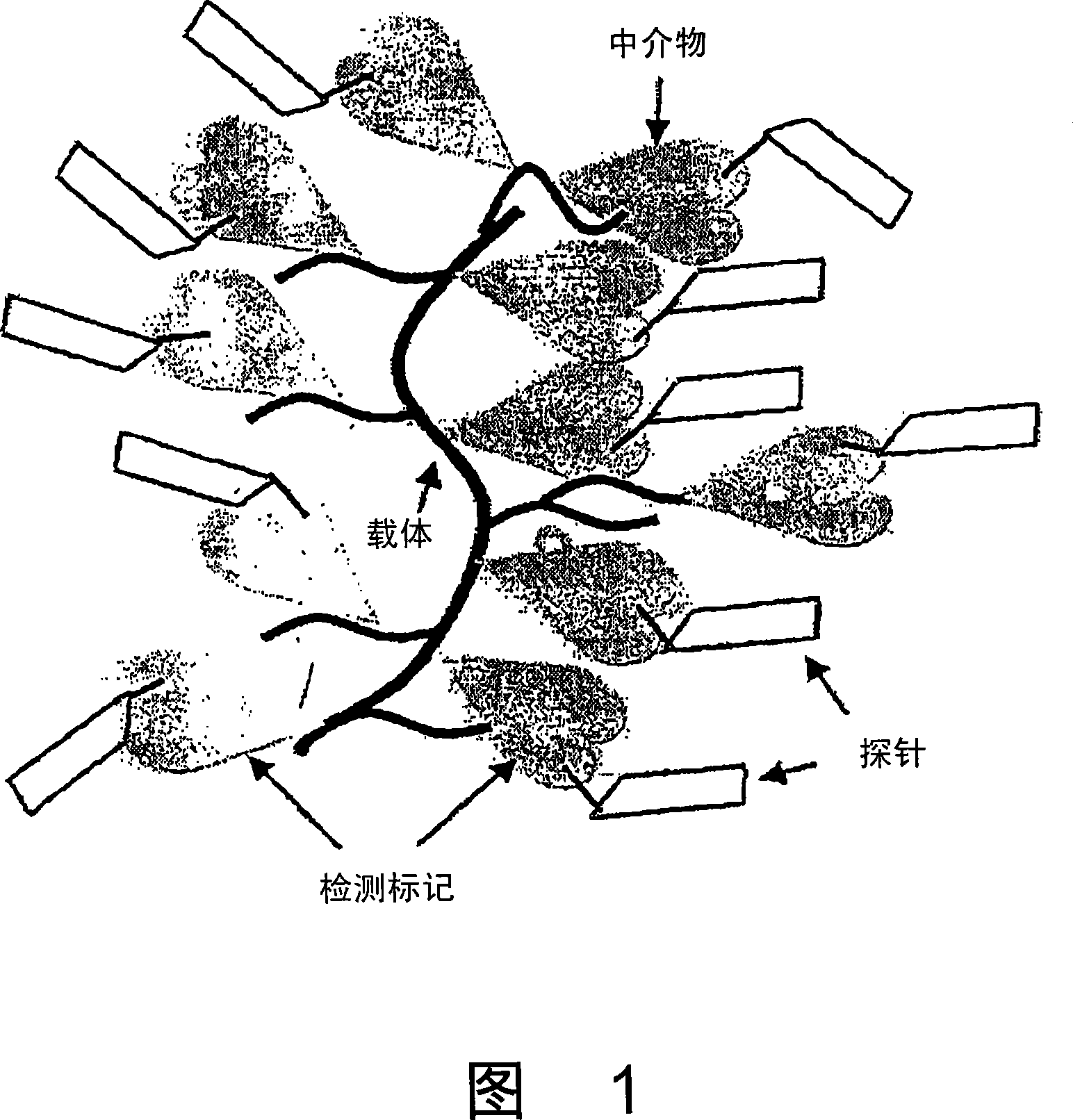Probe complex
A technology of complexes and probes, which can be used in biological testing, material inspection products, measuring devices, etc., and can solve problems such as hindering sensitivity
- Summary
- Abstract
- Description
- Claims
- Application Information
AI Technical Summary
Problems solved by technology
Method used
Image
Examples
Embodiment 1
[0048] Production of Biotin-anti-HCV Core Antigen Monoclonal Antibody Complex Using Ficoll 400 as Carrier
[0049] 44 mg of Ficoll 400 (Amersham Bioscienses) was weighed and dissolved in 0.8 mL of 0.1 M phosphate buffer (pH 7.0), 0.4 mL of sodium periodate solution was added and mixed. After incubation at room temperature for 2 hours, excess sodium periodate was removed by gel filtration (SephadexG25, Amersham Bioscienses), bovine serum albumin (BSA) solution was added and reacted at room temperature for 3 hours, and BSA was added to Ficoll. To stabilize the reaction product, dimethylamine borate (DMAB; Seikagaku Corporation) was added and mixed, reacted at room temperature for 1 hour, and then Tris solution was added to block the unreacted aldehyde groups on Fenco. After overnight reaction at room temperature, the reaction product was purified by gel filtration (Sephacryl S300, 1.6×30), and the absorbance at 280 nm was measured to calculate the concentration of the carrier-BS...
Embodiment 2
[0051] Preparation of biotinylated anti-HCV core antigen monoclonal antibody by conventional method
[0052] Biotinylated antibodies were prepared as described in the attached document Sulfo-NHS-LC-Biotin (Pierce #21335). Mix sulfo-NHS-LC-biotin and anti-HCV core antigen monoclonal antibody (a mixture of equal amounts of C11-14 IgG and C11-9 IgG) in PBS and incubate at room temperature for 1 h, then pass through gel filtration ( Sephadex G25, Amersham Biosciences) to remove excess sulfo-NHS-LC-biotin. The absorbance at 280 nm of the biotinylated anti-HCV core antigen monoclonal antibody was measured to calculate the antibody concentration.
Embodiment 3
[0054] Comparison of the biotin-anti-HCV core antigen monoclonal antibody complex prepared in Example 1 and the biotinylated anti-HCV core antigen monoclonal antibody prepared by conventional methods in Example 2.
[0055] Adjust the anti-HCV core antigen monoclonal antibody to 4 μg / mL with 0.1M acetate / 0.1M phosphate buffer (pH 4.8), add 250 μl to each well of a 96-well microplate, and place each well at 4 Incubate overnight at °C. After washing with PBS, 350 μl of 0.5% casein was added to each well, and each well was incubated at room temperature for 3 hours. Add recombinant HCV core antigen (c11) with concentrations of 0fmol / L, 148fmol / L, 444fmol / L, 1333fmol / L, 4000fmol / L, 12000fmol / L and 36000fmol / L as samples, and incubate each well with stirring at room temperature 1 hour. After washing 6 times with 10 mM phosphate buffer pH 7.3 (washing solution) containing 0.05% Tween 20, the biotin-anti-HCV core antigen monoclonal prepared in Example 1 with a concentration of 1 μg / m...
PUM
| Property | Measurement | Unit |
|---|---|---|
| absorbance | aaaaa | aaaaa |
Abstract
Description
Claims
Application Information
 Login to View More
Login to View More - R&D
- Intellectual Property
- Life Sciences
- Materials
- Tech Scout
- Unparalleled Data Quality
- Higher Quality Content
- 60% Fewer Hallucinations
Browse by: Latest US Patents, China's latest patents, Technical Efficacy Thesaurus, Application Domain, Technology Topic, Popular Technical Reports.
© 2025 PatSnap. All rights reserved.Legal|Privacy policy|Modern Slavery Act Transparency Statement|Sitemap|About US| Contact US: help@patsnap.com

